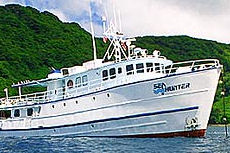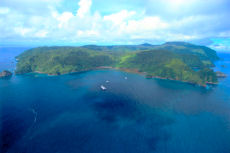Llantrisant
Sub-Aqua Club
www.llantrisantdivers.com
|
|
|
|
|
|
|
|
| |
|
|
Travel
Medicines
& First Aid Kit
|
|
|
|
|
|
 Before
going abroad on a diving trip or an expedition, the leader
or organiser should take time to consider some important health
matters:- Before
going abroad on a diving trip or an expedition, the leader
or organiser should take time to consider some important health
matters:-
In addition to the recommended vaccination requirements
and malaria prophylaxis, every member of the party should
be certified medically fit to dive and be in a good state
of health.
The leader or organiser should also ensure that there
is reasonable access to hyperbaric facilities from the dive
sites.
If you are organising an expedition to some remote
location that is well away from normal tourist areas you should
consider including a doctor in the party.
 If
you are going on a diving trip to a location near well-established
tourist resorts then you will probably be able to use local
medical facilities. Most of the better dive centres and live-aboards
carry a first aid kit, oxygen equipment and basic medical
items. If
you are going on a diving trip to a location near well-established
tourist resorts then you will probably be able to use local
medical facilities. Most of the better dive centres and live-aboards
carry a first aid kit, oxygen equipment and basic medical
items.
In either case you should consider taking your own
medical supplies and basic first aid kit, the size and contents
of which will vary according to the number in the party, the
duration of the trip, local facilities and the remoteness
of the location.
In
the case of an expedition to a remote area where no medical
facilities exist, the party will have to be self sufficient.
Specialist advice must be obtained regarding the contents
of a medical kit since it is likely to require such items
as antibiotics, strong pain killers and other prescription
drugs. The contents of this type of kit are not covered here.
For
lots more information on expedition medicines go to this web
site:-
 If
you are going on an organised trip to a diving resort
or on a live aboard you should take a small medical kit with
you to treat the conditions that most commonly occur among
travellers. It may not be possible to obtain the medicines
when they are needed. If
you are going on an organised trip to a diving resort
or on a live aboard you should take a small medical kit with
you to treat the conditions that most commonly occur among
travellers. It may not be possible to obtain the medicines
when they are needed.
Because
there are so many medicines and first aid items to choose
from, it can be difficult to know exactly what to take. The
following lists have been compiled in order to help you to
choose appropriate items for inclusion in your kit.
Most
of the items listed below should be available in major
towns and cities, but may not be available at the dive resort.
Another problem is the difference in the names of certain
drugs in different countries and making yourself understood
when trying to obtain them.
The
medical kit should contain some or all of the items listed
below. It is unlikely that every item will
be required but each item may be required and therefore should
be considered for inclusion in the kit.
The
kit is designed to be shared amongst a group of people and
therefore exclude items of a personal nature such as items
for personal hygiene, contraception, etc. Each individual
should be encouraged to carry the following items:-
- Sun cream
or lotion of a sufficiently high factor for the area visited.
- After
sun lotion just in case.
- Lip Salve.
- Insect
repellent (containing DEET or similar
|
|
|
|
As already
mentioned; the number in the party, length of stay, the area
visited and local facilities will determine the exact contents
of the kit but you should consider taking some or all of the
following items.
|
The
list of Travel Medicines
|
- Loperamide Capsules 2mg - For the treatment of diarrhoea
- Take two capsules at the onset followed by one capsule
with every loose motion up to a maximum of six capsules
in 24 hours. e.g. Imodium, Arret.
- Domperidone Tablets 10mg - For the treatment of nausea,
vomitting, stomach cramps and bloating associated
with stomach upsets and mild food poisoning. Take
one tablet three times a day. e.g. Motilium.
- Dioralyte Sachets - For replacing body fluids
following dehydration, diarrhoea etc. - Dissolve the
contents of one sachet in approx. 200ml of drinking
water.
- Antacid Tablets - For the relief of indigestion,
heartburn & trapped wind - Suck or chew One or
two tablets as required up to a maximum of twelve
in 24 hours. e.g. Setlers, Andrews Antacid.
- Paracetamol Tablets - For the treatment of mild
to moderate pain, feverishness, colds & flu. -
Take two tablets when required up to a maximum of
eight in 24 hours.
- Co-Codamol Tablets - For the treatment of moderate
to severe pain - Take two tablets when required up
to a maximum of eight in 24 hours. WARNING:
these tablets also contain Paracetamol and not more
than a total of eight should be taken in 24 hours
if taken in conjunction with paracetamol tablets.
- Ibuprofen Tablets 200mg - For the relief of pain and
Inflammation including muscular pain, neuralgia, rheumatic
pains, dental pain and period pains. - Take two tablets
three times a day as required. e.g. Nurofen.
- Pseudoephedrine Tablets 60mg - A decongestant of the of
the mucous membranes of the nose and sinuses and used
for the symptomatic relief of colds, flu, sinusitis
and allergic rhinitis. Take one tablet three times
a day. e.g. Sudafed.
- Antihistamine Tablets - For relief of allergic conditions
such as hay fever and also for relief of insect bites
and nettle rash. - Take one tablet daily. e.g. Clarityn,
Zirtek.
- Cinnarizine Tablets 15mg - For the treatment of motion
sickness, nausea and vertigo. - Take two tablets 2
hours before travelling then one every eight hours
as required or one tablet three times a day. e.g.
Stugeron.
- Bisacodyl Tablets 5mg - For the treatment of constipation.
Take two tablets at night. e.g. Dulcolax Tablets.
- Hydrocortisone Cream 1% - For the treatment of skin
rashes, insect bites, nettle rash, skin allergies
etc. Apply sparingly twice daily.
- Aluminium Acetate Ear Drops - For the prevention of "Swimmers
Ear" or otitis externa. After the last dive of the
day, wash out and thoroughly dry the ear canal without
poking anything into it, then instil four drops into
each ear canal and hold it there for a few minutes
with cotton wool or tissue.
- Hypromellose Eye Drops 10ml - Used to replace natural
tears to relieve dry eyes and to help lubricate the
eyes. Instil two drops into the affected eyes when
required. The drops are sterile until opened and should
be discarded 28 days after opening.
|
|
|
|
|
The
First Aid Kit
|
- Antiseptics - Savlon cream & Savlon
Dry spray.
- Plasters - assorted sizes or a single strip.
- 3" Crepe Bandage.
- Small wound dressing.
- Non adherent dressings.
- Wound closures - Steristrips.
- Micropore tape.
- Zinc Oxide tape.
- Vinegar*- for jellyfish stings.
- Alcohol wipes - mediswabs.
- Cotton Buds.
- Cotton Wool.
- Scissors.
- Tweezers.
- Safety Pins.
*
Vinegar can be carried in small sachets
like the ones you get in motorway cafes!
|
|
|
|
| If you are
travelling outside Europe, particularly to underdeveloped or
third world countries, consider taking with you a set of sterile
needles and syringes. In some parts of the world this type of
equipment is not always sterile before use so there is an increased
risk catching HIV or Hepatitis B. If you do require an injection
whilst away, using your own sterile equipment will help to prevent
infection.
There is
a special kit available from your pharmacy called a "Sterikit
- Medical Emergency Travellers Pack". This pack contains:
|
The
Sterile Kit
|
- Syringes
- Needles
- Pre-Injection Swabs
- Non Adherent dressings
- Microporous Tape
- I.V. Cannula
-
Blood Giving Set
-
Alcohol Free Wipes
-
-
-
-
-
-
There
is also a travellers dental emergency kit available.
|
|
|
For
a range of travel first aid and steri-kits
available on line go to:-

|
|
 |
| SAA
Club 349 |
| |
| |
| |
| |
| |
| |
| |
| |
| |
| |
| |
| |
|
|
Copyright © 2002 -
Llantrisant Sub-Aqua Club. All rights reserved.
|
|